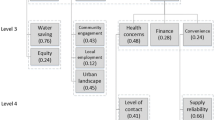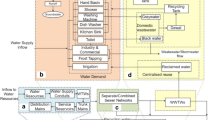Abstract
Purpose
Population growth and urbanization lead to increasing water demand, putting significant pressure on natural water sources. The rising amounts of domestic wastewater (WW) in urban areas may be treated to serve as an alternative water source that may alleviate this pressure. This study examines sustainability of utilizing reclaimed domestic wastewater in urban households for toilet flushing and garden irrigation. It models a city characterized by water scarcity, using a coal-based electricity mix.
Methods
Four approaches were compared: (0) Business-as-usual (BAU) alternative, where the central WW treatment plant effluent is discharged to nature; (1) central WW treatment and urban reuse of the effluent produced; (2) semi-distributed greywater treatment and reuse, at cluster scale; (3) Distributed greywater treatment and reuse, at building scale. Environmental life cycle assessment (LCA), social LCA (S-LCA), and life cycle costing (LCC) were applied to the system model of the above scenarios, with seawater desalination as the source for potable water. System boundaries include water supply, WW collection, and treatment facilities. Analytical hierarchy process (AHP), a multi-criteria decision analysis (MCDA) methodology, was integrated into the life cycle sustainability assessment (LCSA) framework as a means for weighting sustainability criteria through judgment elicitation from a panel of 20 experts.
Results and discussion
Environmentally and socially, the two distributed alternatives perform better in most impact categories. Socially, semi-distributed (cluster scale) reuse is somewhat advantageous over the fully distributed alternative (building scale), due to the benefits of community engagement. Economically, the cluster-level scenario is the most preferable, while the building-scale scenario is the least preferable. A hierarchical representation of the problem’s criteria was constructed, according to the principals of AHP. Each criterion was weighted and those of extreme low importance were eliminated, while maintaining the integrity of the experts’ judgments. Weighted and aggregated sustainability scores revealed that cluster level reclamation, under modeled conditions, is the most sustainable option and the BAU scenario is the least sustainable. The other two alternatives, centralized and fully distributed reclamation, obtained similar intermediate scores.
Conclusions
Distributed urban water reuse was found to be more sustainable than current practice. Different alternative solutions are advantageous in different ways, but overall, the reclamation and reuse of greywater at the cluster level seems to be the best option among the three reuse options examined in this assessment. AHP proved an effective method for aggregating the multiple sustainability criteria. The hierarchical view maintains transparency of all local weights while leading to the final weight vector.





Similar content being viewed by others
Abbreviations
- AHP:
-
Analytical hierarchy process
- BAU:
-
Business as usual
- CR:
-
Consistency ratio
- EOL:
-
End of life
- FU:
-
Functional unit
- GW:
-
Greywater
- LCA:
-
Life cycle assessment
- LCC:
-
Life cycle costing
- LCSA:
-
Life cycle sustainability assessment
- LCT:
-
Life cycle thinking
- MCDA:
-
Multi-criteria decision analysis
- O&M:
-
Operation and maintenance
- PW:
-
Potable water
- RBC:
-
Rotating biological contactor
- RW:
-
Reclaimed water
- S-LCA:
-
Social life cycle assessment
- SWD:
-
Sea water desalination
- WW:
-
Wastewater
- WWTP:
-
Wastewater treatment plant
References
Alfiya Y, Gross A, Sklarz M, Friedler E (2013) Reliability of onsite greywater treatment systems in Mediterranean and arid environments—a case study. WWPR 2012 - Wastewater Purification and Reuse. Crete
Almeida MC, Butler D, Friedler E (1999) At-source domestic wastewater quality. Urban Water J 1:49–55
Arpke A, Hutzler N (2005) Operational life-cycle assessment and life-cycle cost analysis for water use in multioccupant buildings. J Archit Eng 11(3):99–109
Arpke A, Hutzler N (2006) Domestic water use in the United States: a life-cycle approach. J Ind Ecol 10(1–2):169–184
Asano T, Burton FL, Leverenz HL, Tsuchihashi R, Tchobanoglous G (2007) Water reuse: issues, technologies and applications. ISBN-I3: 978-0–-7-145927-3. USA, Metcalf & Eddy Inc.
Bachmann TM (2013) Towards life cycle sustainability assessment: drawing on the NEEDS project’s total cost and multi-criteria decision analysis ranking methods. Int J Life Cycle Assess 18(9):1698–1709
Basurko OC, Mesbahi E (2014) Methodology for the sustainability assessment of marine technologies. J Clean Prod 68:155–164
Cinelli M, Coles SR, Kirwan K (2014) Analysis of the potentials of multi criteria decision analysis methods to conduct sustainability assessment. Ecol Indic 46:138–148
De Felice F, Campagiorni F, Petrillo A (2013) Economic and environmental evaluation via an integrated method based on LCA and MCDA. Procedia-Social and Behav Sci 99:1–10
De Luca AI, Iofrida N, Leskinen P, Stillitano T, Falcone G, Strano A, Gulisano G (2017) Life cycle tools combined with multi-criteria and participatory methods for agricultural sustainability: insights from a systematic and critical review. Sci Total Environ 595:352–370
De Luca AI, Iofrida N, Strano A, Falcone G, Gulisano G (2015) Social life cycle assessment and participatory approaches: a methodological proposal applied to citrus farming in southern Italy. Integr Environ Assess Manage 11(3):383–396
Diaper C, Dixon A, Butler D, Fewkes A, Parsons SA, Strathern M, Stephenson T, Strutt J (2001) Small scale water recycling systems—risk assessment and modelling. Water Sci Technol 43(10):83–90
Domingues AR, Marques P, Garcia R, Freire F, Dias LC (2015) Applying multi-criteria decision analysis to the life-cycle assessment of vehicles. J Clean Prod 107:749–759
Friedler E (2008) The water saving potential and the socio-economic feasibility of greywater reuse within the urban sector—Israel as a case study. Int J Environ Stud 65(1):57–69
Friedler E, Butler D, Alfiya Y (2013) Wastewater composition. In: Larsen TA, Udert KM, Lienert J (eds) Source separation and decentralization for wastewater management. IWA publishing, London, pp 241–258
Friedler E, Hadary M (2006) Economic feasibility of on-site greywater reuse in multi-storey buildings. Desalination 190:221–234
Gross A, Maimon A, Alfiya Y, Friedler E (2015) Greywater reuse. 978-1-822-5504-1. CRC Press, Florida, USA
Høibye L, Clauson-Kaas J, Wenzel H, Larsen HF, Jacobsen BN, Dalgaard O (2008) Sustainability assessment of advanced wastewater treatment technologies. Water Sci Technol 58(5):963–968
Hospido A, Moreira M, Feijoo G (2008) A comparison of municipal wastewater treatment plants for big centres of population in Galicia (Spain). Int J Life Cycle Assess 13(1):57–64
IEC (2015) Uniform electricity tariffs for low voltage supply. Valid from Sept 13, 2015, Israel electric corporation (Hebrew)
Klöpffer W (2008) Life cycle sustainability assessment of products. Int J Life Cycle Assess 13(2):89–95
Machado PA, Urbano L, Brito A, Janknecht P, Rodríguez JJ, Nogueira R (2006) Life cycle assessment of wastewater treatment options for small and decentralized communities: energy-saving systems versus activated sludge. 10th International Conference on Wetland Systems for Water Pollution Control. Lisbon, Portugal, pp 1203–1214
Makropoulos CK, Butler D (2010) Distributed water infrastructure for sustainable communities. Water Resour Manag 24:2795–2816
Muñoz I, Milà-i-Canals L, Fernández-Alba AR (2010) Life cycle assessment of water supply plans in Mediterranean Spain. The Ebro River transfer versus the AGUA Programme. J Ind Ecol 14(6):902–918
Murtagh F (1983) A survey of recent advances in hierarchical clustering algorithms. Comput J 26(4):354–360
Nzila C, Dewulf J, Spanjers H, Tuigong D, Kiriamiti H, van Langenhove H (2012) Multi criteria sustainability assessment of biogas production in Kenya. Appl Energ 93(0):496–506
Opher T, Friedler E (2016) Comparative LCA of decentralized wastewater treatment alternatives for non-potable urban reuse. J Environ Manag 182:464–476
Opher T, Shapira A, Friedler E (2017) A comparative social life cycle assessment of urban domestic water reuse alternatives. Int J Life Cycle Assess doi:https://doi.org/10.1007/s11367-017-1356-1
Ortiz M, Raluy RG, Serra L (2007) Life cycle assessment of water treatment technologies: wastewater and water-reuse in a small town. Desalination 204(1–3):121–131
Pasqualino JC, Meneses M, Abella M, Castells F (2009) LCA as a decision support tool for the environmental improvement of the operation of a municipal wastewater treatment plant. Environ Sci Technol 43(9):3300–3307
Prado-Lopez V, Seager T, Chester M, Laurin L, Bernardo M, Tylock S (2014) Stochastic multi-attribute analysis (SMAA) as an interpretation method for comparative life-cycle assessment (LCA). Int J Life Cycle Assess 19(2):405–416
Recchia L, Boncinelli P, Cini E, Vieri M, Pegna FG, Sarri D (2011). Green energy and technology multicriteria analysis and LCA techniques with applications to agro-engineering problems. 978-0-85729-703-7 (print) 978-0-85729-704-4 (online). London, Springer
Rygaard M, Godskesen B, Jørgensen C, Hoffmann B (2014) Holistic assessment of a secondary water supply for a new development in Copenhagen, Denmark. Sci Total Environ 497–498(0):430–439
Saaty TL (1980). The analytic hierarcy process. N.Y., McGraw-Hill Book Co.
Saaty TL (1990) How to make a decision: the analytic hierarchy process. Eur J Oper Res 48(1):9–26
Saaty TL, Vargas LG (1982) The logic of priorities—applications in business, energy, health and transportation. Springer Science + Business Media, New York
Saaty TL, Vargas LG (2012). International series in operations research & management science models, methods, concepts & applications of the analytic hierarchy process. Second New York, Springer Science+Business Media
Shapira A, Simcha M (2009) AHP-based weighting of factors affecting safety on construction sites with tower cranes. J Constr Eng Manag 135(4):307–318
Sharma AK, Grant AL, Grant T, Pamminger F, Opray L (2009) Environmental and economic assessment of urban water services for a greenfield development. Environ Eng Sci 26(5):921–934
Stokes JR, Horvath A (2009) Energy and air emission effects of water supply. Environ Sci Technol 43:2680–2687
Suh Y-J, Rousseaux P (2002) An LCA of alternative wastewater sludge treatment scenarios. Resour Conserv Recycl 35(3):191–200
UNEP/SETAC (2011) Towards a life cycle sustainability assessment. Making informed choices on products. Life Cycle Initiative, United Nations Environment Programme, Paris, United Nations Environment Programme, pp. 86
Valdivia S, Ugaya CL, Hildenbrand J, Traverso M, Mazijn B, Sonnemann G (2013) A UNEP/SETAC approach towards a life cycle sustainability assessment—our contribution to Rio+20. Int J Life Cycle Assess 18(9):1673–1685
Venkatesh G, Brattebø H (2011) Energy consumption, costs and environmental impacts for urban water cycle services: case study of Oslo (Norway). Energy 36(2):792–800
Ward JHJ (1963) Hierarchical grouping to optimize an objective function. J Am Stat Assoc 58(301):236–244
Wolfslehner B, Brüchert F, Fischbach J, Rammer W, Becker G, Lindner M, Lexer M (2012) Exploratory multi-criteria analysis in sustainability impact assessment of forest-wood chains: the example of a regional case study in Baden–Württemberg. Eur J Forest Res 131(1):47–56
Yue W, Cai Y, Rong Q, Cao L, Wang X (2014) A hybrid MCDA-LCA approach for assessing carbon foot-prints and environmental impacts of China’s paper producing industry and printing services. Environ Syst Res 3(1):1–9
Acknowledgements
We are very grateful to the anonymous experts who took part in this study, contributing their time and expertise.
Funding
This study was partially funded by the Israel Water Authority, under grant 4422444402.
Author information
Authors and Affiliations
Corresponding author
Additional information
Responsible editor: Marzia Traverso
Electronic supplementary material
ESM 1
(PDF 518 kb)
Rights and permissions
About this article
Cite this article
Opher, T., Friedler, E. & Shapira, A. Comparative life cycle sustainability assessment of urban water reuse at various centralization scales. Int J Life Cycle Assess 24, 1319–1332 (2019). https://doi.org/10.1007/s11367-018-1469-1
Received:
Accepted:
Published:
Issue Date:
DOI: https://doi.org/10.1007/s11367-018-1469-1




